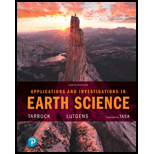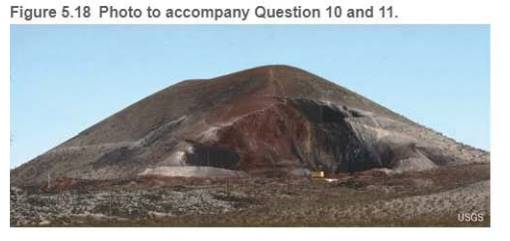
Applications and Investigations in Earth Science (9th Edition)
9th Edition
ISBN: 9780134746241
Author: Edward J. Tarbuck, Frederick K. Lutgens, Dennis G. Tasa
Publisher: PEARSON
expand_more
expand_more
format_list_bulleted
Textbook Question
Chapter 5, Problem 10LR
What type of volcano is shown in Figure 5.18 1?

Expert Solution & Answer
Learn your wayIncludes step-by-step video

schedule03:58
Students have asked these similar questions
Figure 12.7:
A.
B.
A.
B.
C.
D.
E.
A) List and describe the six stages that led to the formation of Earth.
1. Nebular stage
Gravity caused collapse of a rotating mass of dust and gas.
2. A star forms
3. Planetesimals form
4. The Sun ignites
5. Inner planets
6. Outer planets
B) What does the presence of banded iron formation tell us about conditions in the early atmosphere and oceans? (Short answer , couple of sentences)
C)What does the sediment core from Walvis Ridge, southern Atlantic Ocean, from 55-56 million years ago tell us about past climate? (Short answer , couple of sentences )
Chapter 5 Solutions
Applications and Investigations in Earth Science (9th Edition)
Ch. 5.1 - Define magma....Ch. 5.1 - List these magmas in order from the lowest to...Ch. 5.1 - Based on their silica content, which of these...Ch. 5.1 - Which of these magmas tend to produce effusive...Ch. 5.1 - Which of these magmas produce the most explosive...Ch. 5.1 - What two types of volcanoes are associated with...Ch. 5.1 - With what type of volcano are andesitic...Ch. 5.1 - Use Figure 5.2 to complete Question 8 Fill in each...Ch. 5.2 - Measure the slope of Mauna Loas flank using a...Ch. 5.2 - What factor contributes to the gentle slopes...
Ch. 5.2 - What are the small "hills' covered in vegetation...Ch. 5.2 - Figure 5.4 is an image of an eruption on Kilauea,...Ch. 5.2 - Does the lava shown in Figure 5.4 most likely have...Ch. 5.2 - Based on your answer to Question 5, what is the...Ch. 5.3 - Using a protractor, measure the slope of SP Crater...Ch. 5.3 - How does the slope of SP Crater compare to the...Ch. 5.3 - Using the scale, measure the height of SP Crater...Ch. 5.3 - Based on your answer to Question 3, compare the...Ch. 5.3 - Based on Figure 5.5, compare the size of the...Ch. 5.3 - What is the name for the ejected lava fragments...Ch. 5.3 - Given the nature of the materials that make up a...Ch. 5.3 - Using Figure 5.7 arid a piece of siring, measure...Ch. 5.3 - Would you describe the lava that produced this...Ch. 5.4 - Would you describe this as an effusive or...Ch. 5.4 - What name is given to the plume rising from the...Ch. 5.4 - List the primary materials that compose the Mount...Ch. 5.4 - Measure the slope angle near the top of Mount Hood...Ch. 5.4 - Measure the slope near the base of Mount Hood...Ch. 5.4 - Describe how the slope of Mount Hood changes from...Ch. 5.4 - What is the primary cause of the change in slope...Ch. 5.4 - Describe the differences you noticed between the...Ch. 5.5A - Based on the image in Figure 5.11, what type of...Ch. 5.5A - This image also shows that the upper portion of...Ch. 5.5A - What term is used for mudflows that form on...Ch. 5.5A - Can mudflows be triggered when a volcano is not...Ch. 5.5A - Notice in Figure 5.12 that the Osceola Lahar was...Ch. 5.5A - Using a string, measure the distance on Figure...Ch. 5.5A - Assuming that the Osceola Lahar traveled at an...Ch. 5.5A - If monitoring stations were established around the...Ch. 5.5A - What material would be incorporated into a lahar...Ch. 5.5A - What value is gained from dating prehistoric...Ch. 5.5B - What name is given to fast-moving currents of hot...Ch. 5.5B - The average chemical composition of the ash from...Ch. 5.5B - Did the magma that produced the May 18, 1980,...Ch. 5.5B - Use Figure 5.1619, which shows the area destroyed...Ch. 5.5B - Use Figure 5.14 to determine how much volcanic ash...Ch. 5.5B - What is the furthest state from the volcano that...Ch. 5.5B - In what general direction were the upper-level...Ch. 5.5B - Which of the three types of volcanoes discussed...Ch. 5 - Define magma _________________ __________________Ch. 5 - What type of magma has the lowest silica Si02...Ch. 5 - What type of magma has the lowest viscosity?...Ch. 5 - Does the lava flow shown In Figure 5.17 have a...Ch. 5 - What name is given to the nongaseous material...Ch. 5 - Which type of magma tends to produce effusive...Ch. 5 - Which type of magma tends to produce lava domes?Ch. 5 - What two types of volcanoes are associated with...Ch. 5 - Describe the basic shape of a shield volcano.Ch. 5 - What type of volcano is shown in Figure 5.18 1?Ch. 5 - What name is applied to the material being mined...Ch. 5 - Describe how the shape slope of a composite...Ch. 5 - What type of volcanoes are Earths largest?Ch. 5 - What hazard does Mount Rainier pose to the Seattle...Ch. 5 - Figure 5.19 shows a profile view of Newberry...Ch. 5 - What are the small structures that are visible on...
Additional Science Textbook Solutions
Find more solutions based on key concepts
56. Global Positioning System. Learn more about the global positioning system and its uses. Write a short repo...
The Cosmic Perspective (8th Edition)
Why can algae and cyanobacteria be considered indicators of productivity as well as of pollution?
Laboratory Experiments in Microbiology (12th Edition) (What's New in Microbiology)
Problems 30 through 38 describe a situation. For each problem, identify all the forces acting on the object and...
College Physics: A Strategic Approach (3rd Edition)
Although many chimpanzees live in environments with oil palm nuts, members of only a few populations use stones...
Campbell Biology (11th Edition)
6.1 State the number of electrons that be must be lost by atoms of each of the following to achieve a stable el...
Chemistry: An Introduction to General, Organic, and Biological Chemistry (13th Edition)
Two culture media were inoculated with four different bacteria. After incubation, the following results were ob...
Microbiology: An Introduction
Knowledge Booster
Similar questions
- A) List three things that can be measured from annual layers of ice cores. 1 2 3.arrow_forward1. Use the descriptions of shoreline features provided above to label the structures in Figures 12.5 and 12.6. The same feature may appear more than once. 2. Next to each of the features listed below, indicate whether it is the result of erosional or depositional processes.Sea stack: Wave-cut cliff:Spit:Barrier island:Baymouth bar:Marine terrace:arrow_forwardActivity 12.5B: Identifying Shoreline Features on a Topographic Map Pg 209The area shown on the Point Reyes, California, topographic map is located directly to the southwest of the San Andreas Fault, in a very tectonically active region (Figure 12.10). As a result, some of this region has recently been uplifted and exhibits characteristics of an emergent coastline. On the other hand, because of the general rise in sea level over the past several thousand years, other areas exhibit features associated with submergent coastlines. Refer to this topographic map to complete the following. 1. What type of shoreline feature is Drakes Estero (located near the center of the map)? 2. Point Reyes, located in the bottom-left corner of the map, is a headland undergoing severe wave erosion. What type of feature is Chimney Rock, located off the shore of Point Reyes? 3. Several depositional features near Drakes Estero are related to the movement of sediment by longshore currents. What type of…arrow_forward
- Activity 12.3: Wave Refraction Pgs 202-203Figure 12.2 is a map view of a headland along a coastline. The water depths are shown by blue contour lines. As you complete the following questions, assume that waves with a wavelength of 60 feet are approaching the shoreline from the bottom left of the figure. 1. At approximately what water depth-10, 20, 30, or 40 feet-will the approaching waves begin to touch bottom and slow down? (Hint: Recall that this occurs when the water depth is one-half the wavelength.) 2. Using the wave shown in Figure 12.2 as a starting point, sketch a series of lines to illustrate the wave refraction that will occur as the wave approaches the shore by following these steps:Step 1: Mark the position on the 30-foot contour line where the wave front will first touch bottom.Step 2: Knowing that the section of the wave that touches bottom will slow down first, sketch the shape of the wave front when it reaches the 20-foot contour line.Step 3: Using the same…arrow_forwardCan trace and tell me how they did itarrow_forwardCan someone show me how they would trace thisarrow_forward
- I need help with this part E.arrow_forwardDiscussion Question: Ecosystems Essentials A+ shof 1000 Exo-spil The Human Denominator Assignment As we learn about how the earth works, we learn to identify the different earth spheres and how they overlap and affect one another. An understanding of the Earth's systems and spheres takes practice. More importantly, we can see the "Domino Effect" of the spheres as they interact with one another. We have learned that while endogenic processes are separate from exogenic process, the lithosphere affects the atmosphere which affects the hydrosphere, and thearrow_forwardI need help with part c and darrow_forward
arrow_back_ios
SEE MORE QUESTIONS
arrow_forward_ios
Recommended textbooks for you
 Applications and Investigations in Earth Science ...Earth ScienceISBN:9780134746241Author:Edward J. Tarbuck, Frederick K. Lutgens, Dennis G. TasaPublisher:PEARSON
Applications and Investigations in Earth Science ...Earth ScienceISBN:9780134746241Author:Edward J. Tarbuck, Frederick K. Lutgens, Dennis G. TasaPublisher:PEARSON Exercises for Weather & Climate (9th Edition)Earth ScienceISBN:9780134041360Author:Greg CarbonePublisher:PEARSON
Exercises for Weather & Climate (9th Edition)Earth ScienceISBN:9780134041360Author:Greg CarbonePublisher:PEARSON Environmental ScienceEarth ScienceISBN:9781260153125Author:William P Cunningham Prof., Mary Ann Cunningham ProfessorPublisher:McGraw-Hill Education
Environmental ScienceEarth ScienceISBN:9781260153125Author:William P Cunningham Prof., Mary Ann Cunningham ProfessorPublisher:McGraw-Hill Education Earth Science (15th Edition)Earth ScienceISBN:9780134543536Author:Edward J. Tarbuck, Frederick K. Lutgens, Dennis G. TasaPublisher:PEARSON
Earth Science (15th Edition)Earth ScienceISBN:9780134543536Author:Edward J. Tarbuck, Frederick K. Lutgens, Dennis G. TasaPublisher:PEARSON Environmental Science (MindTap Course List)Earth ScienceISBN:9781337569613Author:G. Tyler Miller, Scott SpoolmanPublisher:Cengage Learning
Environmental Science (MindTap Course List)Earth ScienceISBN:9781337569613Author:G. Tyler Miller, Scott SpoolmanPublisher:Cengage Learning Physical GeologyEarth ScienceISBN:9781259916823Author:Plummer, Charles C., CARLSON, Diane H., Hammersley, LisaPublisher:Mcgraw-hill Education,
Physical GeologyEarth ScienceISBN:9781259916823Author:Plummer, Charles C., CARLSON, Diane H., Hammersley, LisaPublisher:Mcgraw-hill Education,

Applications and Investigations in Earth Science ...
Earth Science
ISBN:9780134746241
Author:Edward J. Tarbuck, Frederick K. Lutgens, Dennis G. Tasa
Publisher:PEARSON

Exercises for Weather & Climate (9th Edition)
Earth Science
ISBN:9780134041360
Author:Greg Carbone
Publisher:PEARSON

Environmental Science
Earth Science
ISBN:9781260153125
Author:William P Cunningham Prof., Mary Ann Cunningham Professor
Publisher:McGraw-Hill Education

Earth Science (15th Edition)
Earth Science
ISBN:9780134543536
Author:Edward J. Tarbuck, Frederick K. Lutgens, Dennis G. Tasa
Publisher:PEARSON

Environmental Science (MindTap Course List)
Earth Science
ISBN:9781337569613
Author:G. Tyler Miller, Scott Spoolman
Publisher:Cengage Learning

Physical Geology
Earth Science
ISBN:9781259916823
Author:Plummer, Charles C., CARLSON, Diane H., Hammersley, Lisa
Publisher:Mcgraw-hill Education,